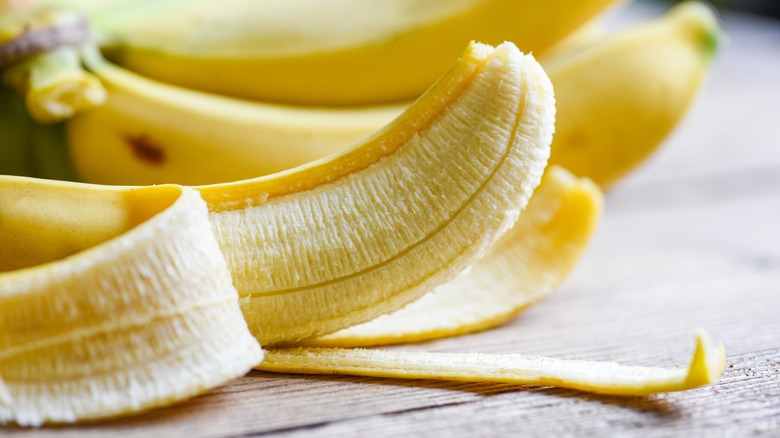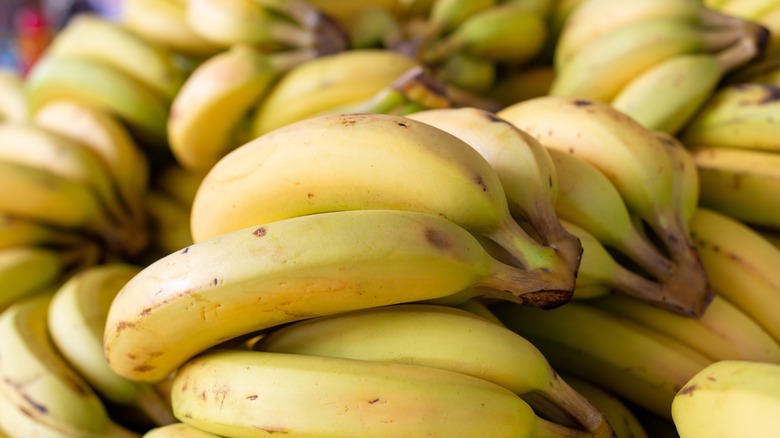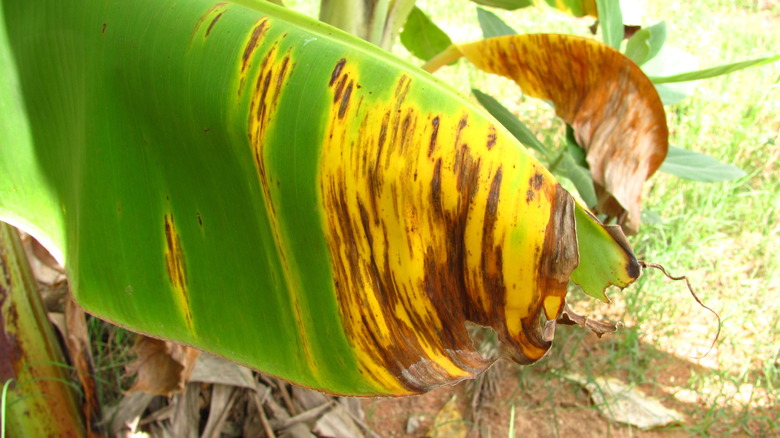The Banana You're Likely Familiar With Could Become Extinct. Here's Why
When you peruse the banana section of your produce department, you don't typically have a lot of choices. You may be able to choose between regular bananas and organic bananas, and you may be able to pick up a plantain, but you won't find a host of different banana varieties. That's because, according to Business Insider, 99% of the bananas exported to developed countries are a single variety of banana: the Cavendish. There are benefits to a monoculture, or cultivating a single variety of a crop, like making the farming and supply chain industries more efficient and cost effective. But there are also dangers inherent in a monoculture.
Biodiversity gives us options. If one crop fails, there are others we can rely on. But if something happens to a crop that's a monoculture, if you've put all your eggs in one basket, so to speak, then upsetting that basket can be catastrophic. We've already seen significant price increases on bananas over the last two years, but is there something else that threatens our beloved bananas: An industry that Business Insider says is worth $25 billion annually.
The Cavendish banana is under attack
Time explains that the average per capita consumption of bananas comes out to about 130 of the delicious yellow fruits every year, a number that's on the rise. And banana lovers have serious cause for concern because there's a fungus, called TR4 or Panama disease, that endangers the Cavendish banana.
But could Panama disease really wipe out an entire variety of banana? Absolutely. And we know that because it's happened before. Another variety of banana, the Gros Michel, was the dominant variety for 80 years before it was nearly exterminated by a different strain of Panama disease. In fact, Time explains the Cavendish banana was selected as the Gros Michel's successor because it was resistant to the earlier strain of the fungus.
Scientists believe the TR4 strain originated in Southeast Asia in the 1990s and began spreading, reaching Colombia in 2019, according to Business Insider. Given that Latin America and the Caribbean produce about 75% of the bananas eaten worldwide, the arrival of Panama disease in Colombia is a big problem because the fungus spreads easily and happens to be difficult to kill.
It's a perfect storm poised to wipe out the Cavendish banana.
What can we do to avert this looming banana disaster?
Banana farmers have implemented rigorous biosecurity measures they hope will prevent — or at least slow down — the spread of TR4 (per Business Insider). These measures, including requiring workers to don clean boots as they enter the farm, using sanitizing footbaths, and installing concrete walkways, are not only expensive, costing just a single Colombian farm an estimated $5 million since 2019, but they're also anything but foolproof. A single car tire that bears soil containing the fungus could infect huge swaths of banana plants, which would have to be destroyed to prevent TR4 from spreading.
Dr. James Dale has actually created a potential solution to the Cavendish catastrophe; In 2019, he genetically modified the Cavendish banana to make it resistant to TR4, but because of the European Union's (EU) resistance to GMOs and consumers' reluctance to purchase them, it's not a perfect fix. Researchers are hard at work breeding disease-resistant varieties of bananas, but that process is complicated by the fact that bananas have a long life cycle, meaning it can take decades to develop a marketable alternative to the Cavendish, according to Time. Another solution, Business Insider points out, would be to begin commercially cultivating other varieties of edible bananas, a complicated process that would likely raise prices throughout the banana supply chain.
For now, until there's competition for the Cavendish, we should savor our banana bread while we can still bake it.


